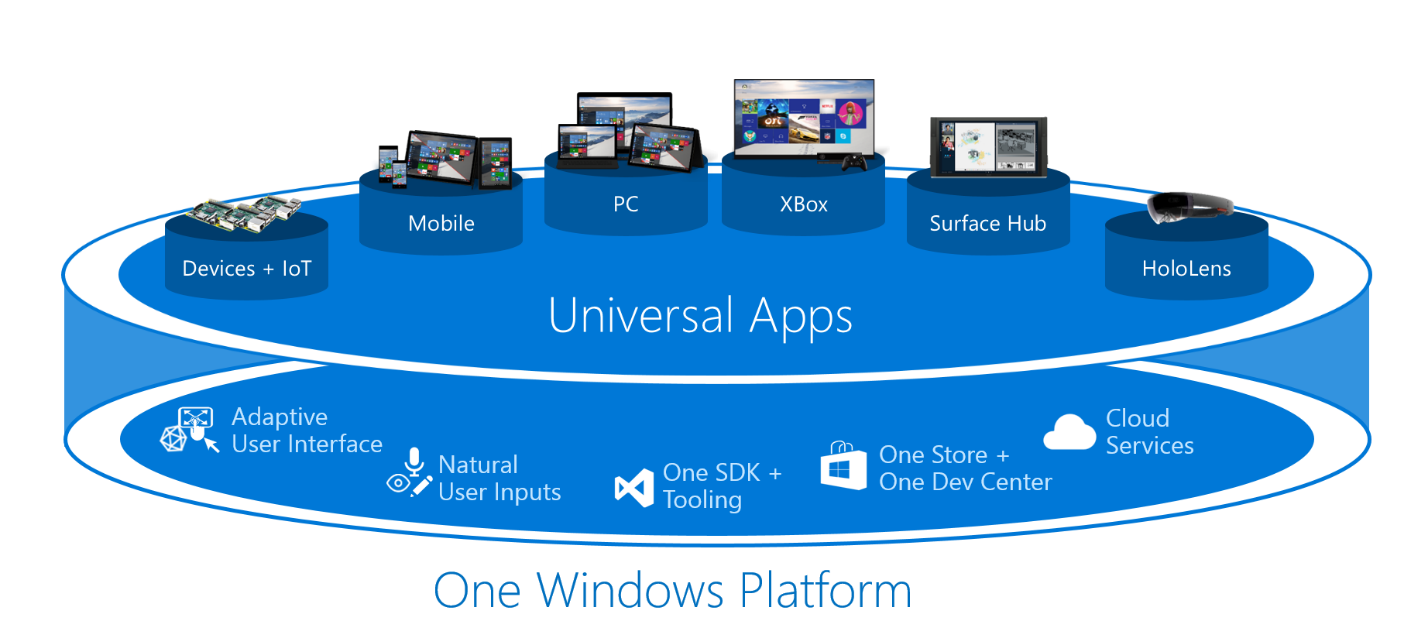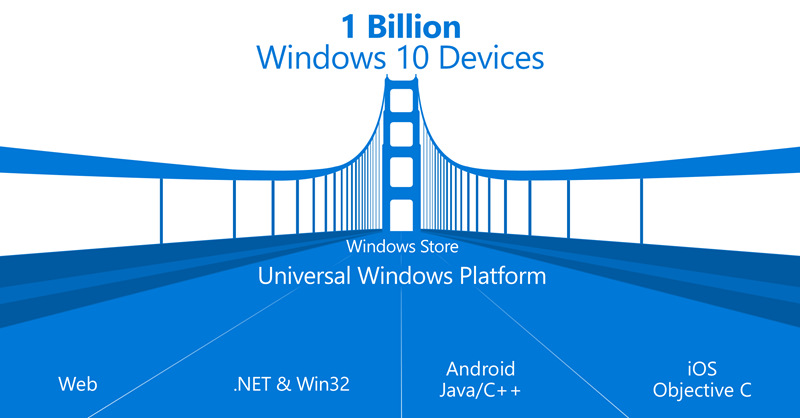Underlying all of those innovations, and connecting them to your apps, is the Universal Windows Platform. In my keynote talk tomorrow (tune in at 8:30am Pacific), I’ll introduce you to how you can take advantage of the new capabilities of the expanded Universal Windows Platform.
But before we get too deep into the technical details, I’d like to set the stage for why we expanded the Universal Windows Platform the way we did and how this helps you as a developer.
As we’ve said before, the goals for this release are to unlock new developer opportunity in the platform by: 1) driving scale through reach across device types, 2) delivering unique and personal experiences, and 3) maximizing developer investments on Windows, no matter where their code was born.
Driving scale through reach across device types
Last year, the Windows platform expanded customer reach across phones, tablets, and PCs. We did this by expanding the Windows 8 runtime to Windows Phone 8.1. For the first time, developers could build universal Windows apps using a unified app model and unified tooling chain that enabled apps to use one shared set of business logic.
Windows 10 (and the apps that run on it) will expand support from phone, tablet, and PC to a number of new device families – including the HoloLens, Xbox One, and IoT devices like the Raspberry Pi 2. With Windows 10, your app – with a single codebase and an adaptable UI – can be as mobile as your users, and reach them on every Windows 10 device. And the Windows Store makes it easy to publish, promote, and monetize your apps and games to capitalize on the global Windows 10 audience of consumer and business customers. For more on the new Windows Store, check back later today for a post from Todd Brix.
Delivering unique and personal experiences
With Windows 10, we’ve made it easier to build mobile experiences that cross device boundaries and create a stronger and personal bond between your app and your users. And using API contracts, through the magic of native .NET and our device family API extensions, it’s possible to create an app that may be tailored at runtime to ‘light up’ on the device it’s running on.
But it’s not just about building apps that run on every device, it’s about creating an experience that crosses them. If you haven’t already seen it, check out Joe’s demonstration of Continuum from Build this morning, which enables you to extend your app experience running on the phone, onto a large screen. When combined with the Universal Windows Platform, your phone app can start using a full-sized monitor, mouse, and keyboard, giving you even more mileage from your universal app’s shared code and UI.
This is just one example of how Windows 10 provides many ways for you to empower users to do great things. From our iconic Live Tiles, to our new Web browser (Microsoft Edge), to Cortana, to the Action Center, developers can integrate and extend Windows capabilities. We know that getting your app installed is the first hurdle – you need to constantly re-engage your users. With Windows 10, we will help increase discovery by connecting customers to apps and features, much like Cortana helps customers today. Over time, you will begin to see curated Store content – apps, desktop software, and games – highlighted for users in places like the new Start menu, lock screen and Cortana.
Maximizing developer investments, no matter where your code was born
Last, but certainly not least, Windows has always been about enabling developer choice (e.g., C++, Java, .NET, Open GL, Ruby, Python, Web, C#, XAML, Silverlight). The Universal Windows Platform and the Windows Store will continue that tradition and will welcome your existing code. As a developer, we recognize that you have existing investments (both in terms of code and skillset), and that providing a way to continue to use those investments is important.
At Build last year, we detailed support for open source and popular middleware partners, we open sourced .NET, and we announced native Cordova support in Visual Studio. Over the past year, we’ve not only delivered on those promises, but also released Visual Studio Community Edition as a free dev environment for students and open source contributors. And, most recently, we partnered with Unity, Unreal, and Cocos2d to be the development environment for game devs.
This morning at Build, Terry introduced how we will make it easier for a wide spectrum of developers to create Windows 10 experiences and provide a bridge onto the Universal Windows Platform and into the Windows Store. We do this via what we’re calling Universal Windows Platform Bridges.
The Universal Windows Platform Bridges model is an exciting advance for the platform. Each Bridge is a combination of developer tooling and runtime technologies that enables existing code to run in a way appropriate to the Windows platform. This morning, we introduced four UWP Bridges toolkits that we will be making available later this year:
- Classic Windows apps – bridge for traditional desktop applications and PC games into the Windows Store, making it easier to distribute and monetize PC games and applications that use .NET and Win32
- Web apps – new ways for websites to get discovered as apps in the Store, engaged by using notifications, and new ways to monetize using Windows Store payment options. Discussed at Mobile World Congress
- For today’s app developer, we gave an early peek at Android Runtime and IOS toolkits that make it easy for developers to extend their reach using their existing code, be it C++, Java, OpenGL, or Objective C
For those developers interested in learning more, check out the Universal Windows Platform Bridges page on the Windows Dev Center. Additionally, interested developers can apply for consideration to the limited developer preview programs for Android Runtime and iOS.
More to come this week
Windows 10, and the Universal Windows Platform, is truly a monumental step in the evolution of Windows. I encourage everyone to download the latest Windows 10 Developer Tools preview.
Don’t forget to tune in to learn more from me via the Build live stream at 8:30 am Pacific. Also, check out all the great Build session content that will be available on Channel 9.



